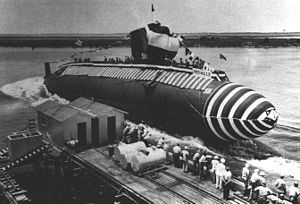You can help expand this article with text translated from the corresponding article in German. (December 2009) Click [show] for important translation instructions.
|
 The launch of USS Blueback in 1959
| |
| Class overview | |
|---|---|
| Name | Barbel class |
| Builders | |
| Operators | |
| Preceded by | USS Darter |
| Built | 1956–1959 |
| In commission | 1959–1990 |
| Completed | 3 |
| Retired | 3 |
| Preserved | 1 |
| General characteristics | |
| Type | Attack submarine |
| Displacement | |
| Length | 219 ft 2 in (66.80 m) overall[2] |
| Beam | 29 ft (8.8 m)[2] |
| Draft | 29 ft (8.8 m) max[2] |
| Propulsion |
|
| Speed |
|
| Range | 14,000 nautical miles (26,000 km) surfaced at 10 knots (19 km/h)[1] |
| Endurance |
|
| Test depth | 700 ft (210 m)[1] |
| Complement | 8 officers, 69 enlisted |
| Sensors and processing systems |
|
| Armament | 6 × 21-inch (533 mm) bow torpedo tubes, 22 torpedoes[1] |
The Barbel-class submarines, the last diesel-electric propelled attack submarines built by the United States Navy, incorporated numerous, radical engineering improvements over previous classes. They were the first production warships built with the teardrop-shape hull first tested on the experimental USS Albacore, and the first to combine the control room, attack center, and conning tower in the same space in the hull. They were of double hull design with 1.5-inch thick HY80 steel. This class of submarine became part of the United States Navy's fleet in 1959 and was taken out of service 1988–1990, leaving the Navy with an entirely nuclear-powered submarine fleet.
The Barbel class' design is considered to be very effective.[3] The Zwaardvis-class submarines of the Netherlands and the Hai Lung class of the Republic of China (designed and built in the Netherlands) were closely derived from the Barbel class design. The Japanese Uzushio class and its successors were also influenced by the Barbel class.
- ^ a b c d e Friedman, Norman (1994). U.S. Submarines Since 1945: An Illustrated Design History. Annapolis, Maryland: United States Naval Institute. pp. 31–35, 242. ISBN 1-55750-260-9.
- ^ a b c d e Bauer, K. Jack; Roberts, Stephen S. (1991). Register of Ships of the U.S. Navy, 1775–1990: Major Combatants. Westport, Connecticut: Greenwood Press. p. 283. ISBN 0-313-26202-0.
- ^ Polmar, Norman and Moore, K. J. (2004). Cold War Submarines: The Design and Construction of U.S. and Soviet Submarines, 1945–2001. Dulles: Potomac Books. ISBN 978-1-57488-594-1, p. 215